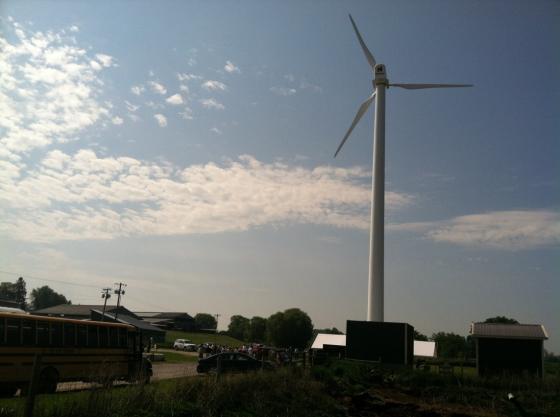Posted March 17, 2022 at 10:36am by Anonymous (not verified)
Wind Energy on a Dairy Farm

Prepared by Alex DePillis, Senior Agricultural Development Coordinator, Vermont Agency of Agriculture, Food and Markets
Highlights: 100 kW of installed capacity ● ≈150,000 kWh generated annually ● Unique partnership with Green Mountain Power facilitates community-scale wind energy installation
The Audet Family has operated Blue Spruce Farm since 1958 and currently milk about 1,500 cows that produce over 30 million pounds (3.6 million gallons) of milk per year. Dairy operations consume quite a bit of electricity. To offset this cost, Blue Spruce Farm was the first participant in the Green Mountain Power (GMP) Cow Power program, which uses anaerobic digestion to turn manure generated on the farm into about 2.4 million kilowatt-hours of electricity per year. Additionally, in 2013 the Audets partnered with GMP to host a 100 kW wind turbine under a unique arrangement that required no cost from the farm. In exchange for locating the wind turbine on their farm, the Audets receive 10% of the electricity, while the remaining 90% is sent on to the grid. As GMP focuses on building small-scale renewable energy projects in their service territory it may be possible for more Vermont farmers—who own a significant amount of Vermont’s land area—to partner with the utility.
Vermont’s Wind Resource
Vermont’s wind resource varies a lot from one place to another due to wind direction, ground obstructions, surface roughness, as well as elevation in relation to the surrounding topography. The strongest wind resources are generally located at higher elevations and that is where Vermont’s four large installations—Kingdom Community Wind, Sheffield Wind, Georgia Mountain Community Wind, and Searsburg Wind Farm—are located. But Vermont also has nearly 200 small-scale net metered wind projects—ranging in size from 0.95 kilowatts (kW) of generating capacity to 100 kW—that are powering homes, schools, businesses, and farms. Farmers can get a first approximation of average annual wind speed on their land using the Renewable Energy Atlas of Vermont.
Installers may also put up an anemometer tower to measure wind speed at the eventual height of the blades, but this can cost upwards of $30,000. For the Blue Spruce Farm wind turbine, contractor Aegis Renewable Energy (Waitsfield) used a wind site analysis tool developed by AWS Truepower. This analysis tool is based on decades of data collection and predicted an average annual wind speed of 11.5 miles per hour (5.14 meters per second) at 120 feet (37 meters) above the ground.
Because of Vermont’s abundant hills and trees, it pays to have a tall wind turbine (i.e., the taller the turbine, the stronger and smoother the wind). At 120 feet tall, the Northern Power Systems wind turbine model 100-24—manufactured in Barre—is well-suited to this moderate wind resource. Each of the three blades is almost 40 feet long, and the turbine includes a mechanism to detect the wind speed and direction in order to face the blades into the wind. The generator for this turbine starts generating power at seven mph (or three m/s), but wind speeds of 10-20 mph are the bread and butter of this turbine’s output profile.
The Northern Power 100-24 is designed for low maintenance. It is gearless and the generator uses permanent magnets to create the electrical field. No gear box also means the NP 100-24 is very quiet. Maintenance personnel climb a ladder inside the turbine to access the generator and blades.
Erecting the turbine was a three-stage process: beginning in early February 2013, Aegis Renewable Energy broke ground for the foundation and began digging trenches for underground electrical service. The contractor first excavated a 15-foot deep hole for the foundation, built the bolt cage assembly and forms for the concrete, and then poured the foundation, which required about 30 yards of concrete.
The concrete foundation cured for 28 days, after which assembly and erection of the tower, nacelle (generator housing), and rotor were completed in two days. Finally, commissioning and utility interconnection took another day and a half. In its first six months, the turbine has operated without interruption. Aegis estimates the turbine will produce about 150,000 kilowatt-hours per year—enough electricity for about 20 Vermont homes.
Learn more about energy efficiency and renewable energy in the Energy section.
